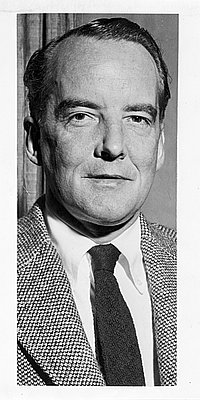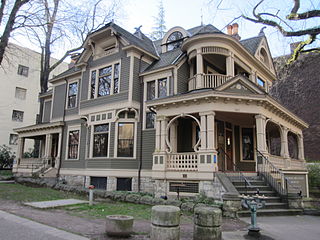
The Pittock Mansion is a French Renaissance-style château in the West Hills of Portland, Oregon, United States. The mansion was originally built in 1914 as a private home for London-born Oregonian publisher Henry Pittock and his wife, Georgiana Burton Pittock. It is a 46-room estate built of Tenino Sandstone situated on 46 acres (19 ha) that is now owned by the city's Bureau of Parks and Recreation and open for touring.

Governor Tom McCall Waterfront Park is a 36.59-acre (148,100 m2) park located in downtown Portland, Oregon, along the Willamette River. After the 1974 removal of Harbor Drive, a major milestone in the freeway removal movement, the park was opened to the public in 1978. The park covers 13 tax lots and is owned by the City of Portland. The park was renamed in 1984 to honor Tom McCall, the Oregon governor who pledged his support for the beautification of the west bank of the Willamette River—harkening back to the City Beautiful plans at the turn of the century which envisioned parks and greenways along the river. The park is bordered by RiverPlace to the south, the Steel Bridge to the north, Naito Parkway to the west, and Willamette River to the east. In October 2012, Waterfront Park was voted one of America's ten greatest public spaces by the American Planning Association.

The Pioneer Courthouse is a federal courthouse in Portland, Oregon, United States. Built beginning in 1869, the structure is the oldest federal building in the Pacific Northwest, and the second-oldest west of the Mississippi River. Along with Pioneer Courthouse Square, it serves as the center of downtown Portland. It is also known as the Pioneer Post Office because a popular downtown Portland post office was, until 2005, located inside. The courthouse is one of four primary locations where the United States Court of Appeals for the Ninth Circuit hears oral arguments. It also houses the chambers of the Portland-based judges on the Ninth Circuit.

The Yeon Building is a historic 59.13 m (194.0 ft), 15-story office building completed in 1911 in downtown Portland, Oregon. Almost completely clad in glazed terra-cotta, and culminating in a colonnade on the top floors, the Yeon Building once was illuminated at night by light sockets built into the cornices, but later removed. The building's namesake is Jean Baptiste Yeon (1865–1928), a self-made timber tycoon who financed the construction. At the time of completion, the Yeon Building was the tallest building in Oregon and it remained so for nearly two years.

John Yeon was an American architect in Portland, Oregon, in the mid-twentieth century. He is regarded as one of the early practitioners of the Northwest Regional style of Modernism. Largely self-taught, Yeon’s wide ranging activities encompassed planning, conservation, historic preservation, art collecting, and urban activism. He was a connoisseur of objets d’art as well as landscapes, and one of Oregon’s most gifted architectural designers, even while his output was limited.

John B. Yeon State Scenic Corridor is a state park in the U.S. state of Oregon, administered by the Oregon Parks and Recreation Department. It is located about 35 miles east of Portland in the Columbia Gorge. It is named in honor of John B. Yeon, one of the principal financiers of the Historic Columbia River Highway U.S. Route 30 which was constructed between 1913 and 1922. Located in the Columbia River Gorge National Scenic Area, the park features hiking trails that access some of the nearby waterfalls, including Elowah Falls.

The Buckler–Henry House, also known as the Grace Peck House, is a historic house in Portland, Oregon, United States. It is one of Portland's few remaining examples of 19th-century brick residential construction. John Buckler built the house in 1891 for Charles K. Henry, a real estate developer who platted the neighborhood in 1890, and subsequently purchased it. Prominent later residents included steamboat captain Jules Olivier and his daughter Grace Olivier Peck, who served in the Oregon House of Representatives for 22 years between 1948 and 1977. In her public life, she focused on social welfare issues and received many accolades from colleagues, governors, and the public.

The Aubrey R. Watzek House is a historic house at 1061 SW Skyline Boulevard in Portland, Oregon, United States. Built in 1936–1937 for a lumber magnate, it was considered a major regional statement of Modern architecture not long after its completion. It was designated a National Historic Landmark on July 25, 2011. It is now part of the University of Oregon's John Yeon Center for Architecture, and is used as a special event facility.

The Visitors Information Center, also known as the Rose Building, is a historic building located on Naito Parkway in downtown Portland, Oregon, United States. Built in 1948, it is noted as a prominent product of its architect John Yeon. It is listed on the National Register of Historic Places.

The Simon Benson House is a 19th-century house located in downtown Portland, Oregon. It was listed on the National Register of Historic Places in 1983.

The Zion Lutheran Church is a church located in downtown Portland, Oregon, listed on the National Register of Historic Places.

Canterbury Castle, also known as Arlington Castle, was a private house located in southwest Portland, Oregon and listed on the National Register of Historic Places. Constructed during 1929–1931, the house was designed by Jeter O. Frye to resemble England's Canterbury Castle on the exterior and to evoke the Art Deco styling of Hollywood of the 1920s on the interior. The house included castle features such as a moat, drawbridge and turret and attracted paying tourists immediately following its completion.

The Meier & Frank Delivery Depot, located in northwest Portland, Oregon, is listed on the National Register of Historic Places. Built for Portland retailing company Meier & Frank, the building was designed by Sutton & Whitney and constructed in 1927. From 1986 to 2001, the building was owned by the Oregon Historical Society, for processing of items and storage of its collections.

Povey Brothers Studio, also known as Povey Brothers Art Glass Works or Povey Bros. Glass Co., was an American producer of stained glass windows based in Portland, Oregon. The studio was active from 1888 to 1928. As the largest and best known art glass company in Oregon, it produced windows for homes, churches, and commercial buildings throughout the West. When the firm was founded in 1888, it was the only creative window firm in Portland, then a city of 42,000 residents.

The W. S. Salmon House in southeast Portland in the U.S. state of Oregon, is a 2.5-story apartment house listed on the National Register of Historic Places. Built in the Queen Anne style in 1890, it was added to the register in 1994.

The Frances Building and Echo Theater in southeast Portland in the U.S. state of Oregon is a property listed on the National Register of Historic Places. Built in 1911, it was added to the register in 1994. The Frances Building is a two-story structure that faces Southeast Hawthorne Boulevard, while the Echo Theatre is a one-story structure facing Southeast 37th Avenue. The adjoining buildings, constructed as parts of a single project, are separated by a party wall.

The Capt. George Raabe House in southeast Portland in the U.S. state of Oregon is a 1.5-story dwelling listed on the National Register of Historic Places. Built in 1902, it was added to the register in 1989.

Lombard Street is a main thoroughfare in North and Northeast Portland, Oregon. It serves as a boundary and main commercial street for several North Portland neighborhoods.




















